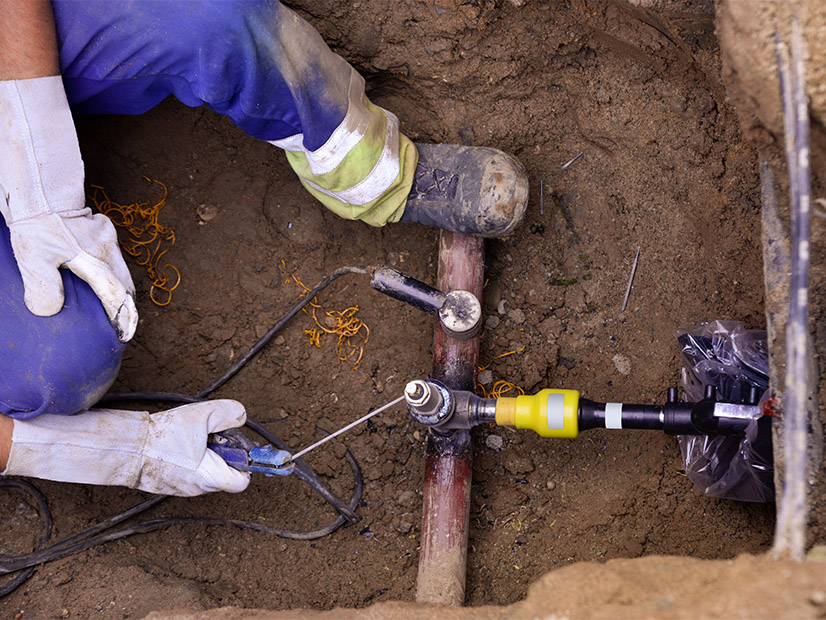Philadelphia Gas Works must spend billions of dollars in the coming decades to replace old, leak-prone pipes as more customers are likely to switch to electric heating, according to a report released Monday by Boston-based nonprofit Home Efficiency Energy Team (HEET).
The report projects the utility will spend $6 billion to $8 billion replacing gas pipelines through 2058 — the date by which PGW aims to replace all cast iron mains, which tend to be the most leaky in its distribution system — with costs increasing 8.5% annually since 2015. Even with that investment, it’s likely that an additional 378 miles of currently leak-prone mains won’t be covered and an additional 379 miles installed during the 1970s and 80s will then be beyond their useful service life.
“It’s extremely likely that we’re going to get to 2058 and we’ll have a pile of vintage pipeline that hasn’t been replaced,” said Dorie Seavey, the HEET economist who wrote the report.
PGW did not return requests for comment on this article but did provide a statement on the report.
“The pursuit of carbon neutrality involves balancing the often-competing goals of safety, reliability, affordability and sustainability,” PGW spokesperson Richard Barnes said. “HEET’s use of data and analytics presents precisely the type of informed debate that is necessary to make progress. While the considerations and impacts we must weigh are broader than those of HEET’s study, we welcome and even pursue other perspectives and particularly expertise from other markets and geographic regions.”
The utility implemented an accelerated main replacement program in 2013, which funds additional replacements above the baseline of approximately 18 miles of gas mains per year, through a ratepayer surcharge, bringing total replacements to between 27 and 37 miles per year between 2016 and 2021. The report estimated that it would take an additional 10.5 miles per year to address all leak-prone pipes by 2058, which would add $1.7 billion to $2 billion to the overall cost.
PGW is also making significant investments in gas processing infrastructure, adding around $200 million to its five-year capital plan to make upgrades to its LNG equipment and to replace a liquefier at its Richmond plant.
Between rising infrastructure and fuel prices and the growing affordability of electrification for consumers, Seavey said, the rising cost of maintaining the gas infrastructure will likely fall on a shrinking number of customers. The report notes that Philadelphia has one of the highest rates of customers receiving assistance with their energy bills, effectively making PGW dependent on federal subsidies.
“The economics of gas is changing, and some degree of electrification is inevitable. To the extent that gas demand and throughput decline, and customers migrate to other thermal energy sources, then gas utility distribution spending will need to be recovered from fewer customers. Customers who don’t electrify, or are unable to (such as tenants and low-income households), will be left on an increasingly costly gas system,” the report says.
The 2058 goal could also put PGW in conflict with the city’s commitment to reach net-zero carbon emissions by 2050 should it continue using the infrastructure to deliver natural gas.
The report notes that PGW’s June 2021 Methane Reduction Report says the utility is exploring renewable natural gas (RNG) as an alternative fuel, but it also points to a December 2021 Business Diversification Study prepared for the company that says RNG could come with numerous downsides, including “limited available resources, high fuel costs and limited air quality improvements.”
Networked Geothermal Offers Alternative
HEET Codirector Audrey Schulman said thermal energy networks, which use piped water to deliver both heating and cooling, providing a sustainable option that avoids putting the burden of electrification directly onto consumers. The city council allocated $500,000 in PGW’s 2023 capital budget for a feasibility study on networked geothermal.
“Philadelphia has always been innovative in this area and thoughtful, and this is an opportunity for Philadelphia to move forward in an innovative way,” she said.
HEET has been involved in a networked geothermal installation in Framingham, Mass., which will provide air conditioning for a school, fire station, businesses and over 40 homes starting this summer. (See Nonprofit Plans River-source Geothermal in Eastern Mass.)
New York is also experimenting with the technology through the Utility Thermal Energy Network and Jobs Act of 2022, which permits utilities to install and operate the networks and requires larger utilities to submit pilot programs. (See NY Governor Signs Clean Building Codes, Thermal Networks Legislation.)
The HEET report also pointed to synchronizing clusters of electrified buildings with retiring gas infrastructure and using innovations in leak repair and monitoring to extend the lifespan of existing pipes.
“As PGW explores geothermal and other alternatives for Philadelphia, we look forward to partnering with HEET and other organizations to help crystalize the energy opportunities that lie ahead,” PGW’s Barnes said in the utility’s statement about the report.
Mitch Chanin, of POWER Philadelphia, an activist group that worked with HEET on the report, said his group is concerned about the public safety and environmental risk leaking gas mains pose within the city, noting there have been multiple explosions — some fatal — in recent years. The organization is pushing the city to consider several alternatives to natural gas, including thermal networks, energy efficiency, home retrofits and heat pumps.
Given PGW’s status as a public utility and its experience installing underground infrastructure throughout the city, the company is well-positioned to be at the forefront of any effort to install networked geothermal, Chanin said. Working at utility scale also comes with the prospect of lowering the cost of electrification for the city’s low-income residents and lessening the electric load impact of the shift.
“As we plan for the future of Philadelphia, this is really important, and we cannot achieve our city’s climate goals without shifts at PGW. We don’t have a plan yet that matches our goal,” he said.



